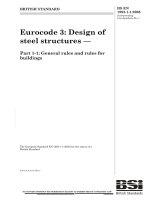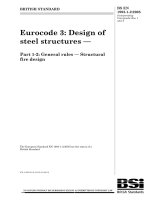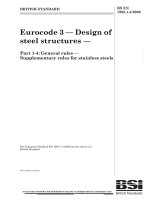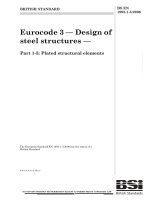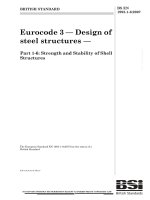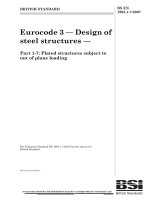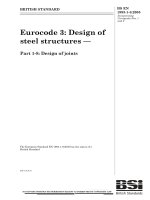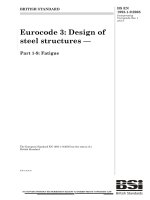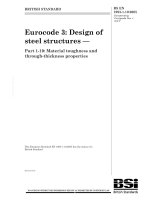Tiêu chuẩn Châu Âu EC9: Kết cấu nhôm phần 1.1: Quy định chung (Eurocode9 BS EN1999 1 1 e 2007 general structural rules Design of aluminum structures part 1.1: General structural rules)
Bạn đang xem bản rút gọn của tài liệu. Xem và tải ngay bản đầy đủ của tài liệu tại đây (2.04 MB, 210 trang )
BRITISH STANDARD
Eurocode 9: Design of
aluminium structures —
Part 1-1: General structural rules
The European Standard EN 1999-1-1:2007 has the status of a
British Standard
ICS 77.150.10; 91.010.30; 91.080.10
12 &23<,1* :,7+287 %6, 3(50,66,21 (;&(37 $6 3(50,77(' %< &23<5,*+7 /$:
BS EN
1999-1-1:2007
BS EN 1999-1-1:2007
National foreword
This British Standard is the UK implementation of EN 1999-1-1:2007. It
supersedes DD ENV 1999-1-1:2000 which is withdrawn. Details of superseded
British Standards are given in the table below.
The structural Eurocodes are divided into packages by grouping Eurocodes for
each of the main materials: concrete, steel, composite concrete and steel,
timber, masonry and aluminium; this is to enable a common date of withdrawal
(DOW) for all the relevant parts that are needed for a particular design. The
conflicting national standards will be withdrawn at the end of the coexistence
period, after all the EN Eurocodes of a package are available.
Following publication of the EN, there is a period allowed for national
calibration during which the National Annex is issued, followed by a further
coexistence period of a maximum three years. During the coexistence period
Member States will be encouraged to adapt their national provisions to
withdraw conflicting national rules before the end of the coexistence period in
March 2010. At the end of this coexistence period, the national standard(s) will
be withdrawn.
In the UK, the following national standards are superseded by the Eurocode 9
series. These standards will be withdrawn on a date to be announced.
Eurocode
Superseded British Standards
EN 1999-1-1
BS 8118-2:1991
DD ENV 1999-1-1:2000
BS 8118-1:1991 (partial)
DD ENV 1999-1-2:2000
DD ENV 1999-2:2000
BS 8118-1:1991 (partial)
BS 8118-1:1991 (partial)
None
EN 1999-1-2
EN 1999-1-3
EN 1999-1-4
EN 1999-1-5
The UK participation in its preparation was entrusted by Technical Committee
B/525, Building and civil engineering structures, to Subcommittee B/525/9,
Structural use of aluminium.
A list of organizations represented on this committee can be obtained on
request to its secretary.
Where a normative part of this EN allows for a choice to be made at the national
level, the range and possible choice will be given in the normative text, and a
note will qualify it as a Nationally Determined Parameter (NDP). NDPs can be
a specific value for a factor, a specific level or class, a particular method or a
particular application rule if several are proposed in the EN.
To enable EN 1999-1-1 to be used in the UK, the NDPs will be published in a
National Annex, which will be made available by BSI in due course, after public
consultation has taken place.
This publication does not purport to include all the necessary provisions of a
contract. Users are responsible for its correct application.
Compliance with a British Standard cannot confer immunity from
legal obligations.
This British Standard was
published under the authority
of the Standards Policy and
Strategy Committee
on 31 Auguat 2007
© BSI 2007
ISBN 978 0 580 50415 0
Amendments issued since publication
Amd. No.
Date
Comments
EUROPEAN STANDARD
EN 1999-1-1
NORME EUROPÉENNE
EUROPÄISCHE NORM
May 2007
ICS 91.010.30; 91.080.10
Supersedes ENV 1999-1-1:1998
English Version
Eurocode 9: Design of aluminium structures - Part 1-1: General
structural rules
Eurocode 9: Calcul des structures en aluminium - Partie 11: Règles générales
Eurocode 9: Bemessung und Konstruktion von
Aluminiumtragwerken - Teil 1-1: Allgemeine
Bemessungsregeln
This European Standard was approved by CEN on 18 September 2006.
CEN members are bound to comply with the CEN/CENELEC Internal Regulations which stipulate the conditions for giving this European
Standard the status of a national standard without any alteration. Up-to-date lists and bibliographical references concerning such national
standards may be obtained on application to the CEN Management Centre or to any CEN member.
This European Standard exists in three official versions (English, French, German). A version in any other language made by translation
under the responsibility of a CEN member into its own language and notified to the CEN Management Centre has the same status as the
official versions.
CEN members are the national standards bodies of Austria, Belgium, Bulgaria, Cyprus, Czech Republic, Denmark, Estonia, Finland,
France, Germany, Greece, Hungary, Iceland, Ireland, Italy, Latvia, Lithuania, Luxembourg, Malta, Netherlands, Norway, Poland, Portugal,
Romania, Slovakia, Slovenia, Spain, Sweden, Switzerland and United Kingdom.
EUROPEAN COMMITTEE FOR STANDARDIZATION
COMITÉ EUROPÉEN DE NORMALISATION
EUROPÄISCHES KOMITEE FÜR NORMUNG
Management Centre: rue de Stassart, 36
© 2007 CEN
All rights of exploitation in any form and by any means reserved
worldwide for CEN national Members.
B-1050 Brussels
Ref. No. EN 1999-1-1:2007: E
EN 1999-1-1: 2007 (E)
Content
Page
Foreword .......................................................................................................................................................... 7
1
General ................................................................................................................................................... 11
1.1
Scope ............................................................................................................................................... 11
1.1.1
Scope of EN 1999.................................................................................................................... 11
1.1.2
Scope of EN 1999-1-1 ............................................................................................................. 11
1.2
Normative references....................................................................................................................... 12
1.2.1
General references ................................................................................................................... 12
1.2.2
References on structural design ............................................................................................... 12
1.2.3
References on aluminium alloys.............................................................................................. 13
1.2.4
References on welding............................................................................................................. 15
1.2.5
Other references....................................................................................................................... 15
1.3
Assumptions .................................................................................................................................... 16
1.4
Distinction between principles and application rules ...................................................................... 16
1.5
Terms and definitions ...................................................................................................................... 16
1.6
Symbols ........................................................................................................................................... 17
1.7
Conventions for member axes ......................................................................................................... 27
1.8
Specification for execution of the work........................................................................................... 27
2
Basis of design ........................................................................................................................................ 29
2.1
Requirements ................................................................................................................................... 29
2.1.1
Basic requirements................................................................................................................... 29
2.1.2
Reliability management ........................................................................................................... 29
2.1.3
Design working life, durability and robustness ....................................................................... 29
2.2
Principles of limit state design......................................................................................................... 29
2.3
Basic variables................................................................................................................................. 30
2.3.1
Actions and environmental influences..................................................................................... 30
2.3.2
Material and product properties............................................................................................... 30
2.4
Verification by the partial factor method......................................................................................... 30
2.4.1
Design value of material properties......................................................................................... 30
2.4.2
Design value of geometrical data ............................................................................................ 30
2.4.3
Design resistances.................................................................................................................... 30
2.4.4
Verification of static equilibrium (EQU)................................................................................. 31
2.5
Design assisted by testing................................................................................................................ 31
3
Materials................................................................................................................................................. 32
3.1
General............................................................................................................................................. 32
3.2
Structural aluminium ....................................................................................................................... 32
3.2.1
Range of materials ................................................................................................................... 32
3.2.2
Material properties for wrought aluminium alloys .................................................................. 33
3.2.3
Material properties for cast aluminium alloys ......................................................................... 36
3.2.4
Dimensions, mass and tolerances ............................................................................................ 37
3.2.5
Design values of material constants......................................................................................... 37
3.3
Connecting devices.......................................................................................................................... 38
3.3.1
General..................................................................................................................................... 38
3.3.2
Bolts, nuts and washers............................................................................................................ 38
3.3.3
Rivets ....................................................................................................................................... 39
3.3.4
Welding consumables.............................................................................................................. 40
3.3.5
Adhesives................................................................................................................................. 42
4
Durability ............................................................................................................................................... 42
5
Structural analysis................................................................................................................................. 43
5.1
Structural modelling for analysis..................................................................................................... 43
5.1.1
Structural modelling and basic assumptions............................................................................ 43
5.1.2
Joint modelling ........................................................................................................................ 43
5.1.3
Ground-structure interaction.................................................................................................... 43
5.2
Global analysis ................................................................................................................................ 43
2
EN 1999-1-1: 2007 (E)
Effects of deformed geometry of the structure.........................................................................43
5.2.1
5.2.2
Structural stability of frames ....................................................................................................44
5.3
Imperfections....................................................................................................................................45
5.3.1
Basis .........................................................................................................................................45
5.3.2
Imperfections for global analysis of frames .............................................................................45
5.3.3
Imperfection for analysis of bracing systems ...........................................................................49
5.3.4
Member imperfections .............................................................................................................52
5.4
Methods of analysis..........................................................................................................................52
5.4.1
General .....................................................................................................................................52
5.4.2
Elastic global analysis ..............................................................................................................52
5.4.3
Plastic global analysis ..............................................................................................................52
6
Ultimate limit states for members.........................................................................................................53
6.1
Basis .................................................................................................................................................53
6.1.1
General .....................................................................................................................................53
6.1.2
Characteristic value of strength ................................................................................................53
6.1.3
Partial safety factors .................................................................................................................53
6.1.4
Classification of cross-sections ................................................................................................53
6.1.5
Local buckling resistance .........................................................................................................58
6.1.6
HAZ softening adjacent to welds .............................................................................................59
6.2
Resistance of cross-sections .............................................................................................................61
6.2.1
General .....................................................................................................................................61
6.2.2
Section properties .....................................................................................................................62
6.2.3
Tension .....................................................................................................................................63
6.2.4
Compression.............................................................................................................................64
6.2.5
Bending moment ......................................................................................................................64
6.2.6
Shear.........................................................................................................................................66
6.2.7
Torsion......................................................................................................................................67
6.2.8
Bending and shear ....................................................................................................................69
6.2.9
Bending and axial force............................................................................................................69
6.2.10 Bending, shear and axial force .................................................................................................71
6.2.11 Web bearing .............................................................................................................................71
6.3
Buckling resistance of members.......................................................................................................71
6.3.1
Members in compression..........................................................................................................71
6.3.2
Members in bending.................................................................................................................75
6.3.3
Members in bending and axial compression ............................................................................77
6.4
Uniform built-up members...............................................................................................................80
6.4.1
General .....................................................................................................................................80
6.4.2
Laced compression members ...................................................................................................82
6.4.3
Battened compression members ...............................................................................................83
6.4.4
Closely spaced built-up members.............................................................................................85
6.5
Un-stiffened plates under in-plane loading ......................................................................................85
6.5.1
General .....................................................................................................................................85
6.5.2
Resistance under uniform compression....................................................................................86
6.5.3
Resistance under in-plane moment...........................................................................................87
6.5.4
Resistance under transverse or longitudinal stress gradient .....................................................88
6.5.5
Resistance under shear .............................................................................................................88
6.5.6
Resistance under combined action ...........................................................................................89
6.6
Stiffened plates under in-plane loading............................................................................................89
6.6.1
General .....................................................................................................................................89
6.6.2
Stiffened plates under uniform compression............................................................................90
6.6.3
Stiffened plates under in-plane moment...................................................................................92
6.6.4
Longitudinal stress gradient on multi-stiffened plates .............................................................92
6.6.5
Multi-stiffened plating in shear ................................................................................................93
6.6.6
Buckling load for orthotropic plates.........................................................................................93
6.7
Plate girders......................................................................................................................................96
6.7.1
General .....................................................................................................................................96
6.7.2
Resistance of girders under in-plane bending...........................................................................96
6.7.3
Resistance of girders with longitudinal web stiffeners.............................................................97
3
EN 1999-1-1: 2007 (E)
Resistance to shear................................................................................................................... 98
6.7.4
6.7.5
Resistance to transverse loads ............................................................................................... 102
6.7.6
Interaction.............................................................................................................................. 105
6.7.7
Flange induced buckling........................................................................................................ 106
6.7.8
Web stiffeners........................................................................................................................ 106
6.8
Members with corrugated webs..................................................................................................... 108
6.8.1
Bending moment resistance................................................................................................... 108
6.8.2
Shear force resistance ............................................................................................................ 108
7
Serviceability Limit States .................................................................................................................. 110
7.1
General........................................................................................................................................... 110
7.2
Serviceability limit states for buildings ......................................................................................... 110
7.2.1
Vertical deflections................................................................................................................ 110
7.2.2
Horizontal deflections............................................................................................................ 110
7.2.3
Dynamic effects..................................................................................................................... 110
7.2.4
Calculation of elastic deflection ............................................................................................ 110
8
Design of joints..................................................................................................................................... 111
8.1
Basis of design............................................................................................................................... 111
8.1.1
Introduction ........................................................................................................................... 111
8.1.2
Applied forces and moments ................................................................................................. 111
8.1.3
Resistance of joints................................................................................................................ 111
8.1.4
Design assumptions ............................................................................................................... 112
8.1.5
Fabrication and execution...................................................................................................... 112
8.2
Intersections for bolted, riveted and welded joints ........................................................................ 112
8.3
Joints loaded in shear subject to impact, vibration and/or load reversal ....................................... 113
8.4
Classification of joints ................................................................................................................... 113
8.5
Connections made with bolts, rivets and pins ............................................................................... 113
8.5.1
Positioning of holes for bolts and rivets ................................................................................ 113
8.5.2
Deductions for fastener holes ................................................................................................ 115
8.5.3
Categories of bolted connections........................................................................................... 117
8.5.4
Distribution of forces between fasteners ............................................................................... 119
8.5.5
Design resistances of bolts..................................................................................................... 120
8.5.6
Design resistance of rivets ..................................................................................................... 122
8.5.7
Countersunk bolts and rivets ................................................................................................. 123
8.5.8
Hollow rivets and rivets with mandrel................................................................................... 123
8.5.9
High strength bolts in slip-resistant connections ................................................................... 123
8.5.10 Prying forces.......................................................................................................................... 125
8.5.11 Long joints............................................................................................................................. 125
8.5.12 Single lap joints with fasteners in one row............................................................................ 126
8.5.13 Fasteners through packings.................................................................................................... 126
8.5.14 Pin connections...................................................................................................................... 126
8.6
Welded connections....................................................................................................................... 129
8.6.1
General................................................................................................................................... 129
8.6.2
Heat-affected zone (HAZ) ..................................................................................................... 129
8.6.3
Design of welded connections ............................................................................................... 129
8.7
Hybrid connections........................................................................................................................ 136
8.8
Adhesive bonded connections ....................................................................................................... 136
8.9
Other joining methods ................................................................................................................... 136
Annex A [normative] – Execution classes.................................................................................................. 137
Annex B [normative] - Equivalent T-stub in tension................................................................................ 139
B.1 General rules for evaluation of resistance........................................................................................... 139
B.2 Individual bolt-row, bolt-groups and groups of bolt-rows.................................................................. 143
Annex C [informative] - Materials selection ............................................................................................. 145
C.1
General........................................................................................................................................... 145
C.2
Wrought products .......................................................................................................................... 145
C.2.1
Wrought heat treatable alloys ................................................................................................ 145
4
EN 1999-1-1: 2007 (E)
Wrought non-heat treatable alloys..........................................................................................148
C.2.2
C.3
Cast products ..................................................................................................................................149
C.3.1
General
. .................................................................................................149
C.3.2
Heat treatable casting alloys EN AC-42100, EN AC-42200, EN AC-43000 and..................149
EN AC-43300.........................................................................................................................................149
C.3.3
Non-heat treatable casting alloys EN AC-44200 and EN AC-51300.....................................149
C.3.4
Special design rules for castings.............................................................................................149
C.4
Connecting devices.........................................................................................................................151
C.4.1
Aluminium bolts.....................................................................................................................151
C.4.2
Aluminium rivets....................................................................................................................151
Annex D [informative] – Corrosion and surface protection.....................................................................152
D.1
Corrosion of aluminium under various exposure conditions..........................................................152
D.2
Durability ratings of aluminium alloys...........................................................................................152
D.3
Corrosion protection.......................................................................................................................153
D.3.1
General ...................................................................................................................................153
D.3.2
Overall corrosion protection of structural aluminium ............................................................153
D.3.3
Aluminium in contact with aluminium and other metals .......................................................154
D.3.4
Aluminium surfaces in contact with non-metallic materials ..................................................154
Annex E [informative] - Analytical models for stress strain relationship..............................................159
E.1
Scope ..............................................................................................................................................159
E.2
Analytical models...........................................................................................................................159
E.2.1
Piecewise linear models .........................................................................................................159
E.2.2
Continuous models .................................................................................................................161
E.3
Approximate evaluation of εu .........................................................................................................164
Annex F [informative] - Behaviour of cross-sections beyond the elastic limit.......................................165
F.1
F.2
F.3
F.4
F.5
General ...........................................................................................................................................165
Definition of cross-section limit states...........................................................................................165
Classification of cross-sections according to limit states ...............................................................165
Evaluation of ultimate axial load....................................................................................................166
Evaluation of ultimate bending moment ........................................................................................167
Annex G [informative] - Rotation capacity...............................................................................................169
Annex H [informative] - Plastic hinge method for continuous beams....................................................171
Annex I [informative] - Lateral torsional buckling of beams and torsional or torsional-flexural
buckling of compressed members ...............................................................................................................173
I.1
Elastic critical moment and slenderness.........................................................................................173
I.1.1 Basis
. ....................................................................................................................173
I.1.2 General formula for beams with uniform cross-sections symmetrical about the minor or major
axis
..............................................................................................................................173
I.1.3 Beams with uniform cross-sections symmetrical about major axis, centrally symmetric and
doubly symmetric cross-sections............................................................................................................178
I.1.4 Cantilevers with uniform cross-sections symmetrical about the minor axis
. ............179
I.2
Slenderness for lateral torsional buckling ......................................................................................181
I.3
Elastic critical axial force for torsional and torsional-flexural buckling ........................................183
I.4
Slenderness for torsional and torsional-flexural buckling..............................................................184
Annex J [informative] - Properties of cross sections................................................................................189
J.1
J.2
J.3
J.4
J.5
J.6
Torsion constant It ..........................................................................................................................189
Position of shear centre S ...............................................................................................................189
Warping constant Iw .......................................................................................................................189
Cross section constants for open thin-walled cross sections ..........................................................193
Cross section constants for open cross section with branches........................................................195
Torsion constant and shear center of cross section with closed part ..............................................195
Annex K [informative] - Shear lag effects in member design..................................................................196
5
EN 1999-1-1: 2007 (E)
General........................................................................................................................................... 196
K.1
K.2
Effective width for elastic shear lag .............................................................................................. 196
K.2.1
Effective width factor for shear lag ....................................................................................... 196
K.2.2
Stress distribution for shear lag ............................................................................................. 197
K.2.3
In-plane load effects .............................................................................................................. 198
K.3
Shear lag at ultimate limit states.................................................................................................... 199
Annex L [informative] - Classification of joints........................................................................................ 200
L.1
General........................................................................................................................................... 200
L.2
Fully restoring connections............................................................................................................ 201
L.3
Partially restoring connections ...................................................................................................... 201
L.4
Classification according to rigidity................................................................................................ 201
L.5
Classification according to strength............................................................................................... 202
L.6
Classification according to ductility .............................................................................................. 202
L.7
General design requirements for connections................................................................................ 202
L.8
Requirements for framing connections.......................................................................................... 202
L.8.1
General................................................................................................................................... 202
L.8.2
Nominally pinned connections .............................................................................................. 203
L.8.3
Built-in connections............................................................................................................... 204
Annex M [informative] - Adhesive bonded connections .......................................................................... 205
M.1 General ............................................................................................................................................... 205
M.2 Adhesives........................................................................................................................................... 205
M.3 Design of adhesive bonded joints ...................................................................................................... 206
M.3.1 General ........................................................................................................................................ 206
M.3.2 Characteristic strength of adhesives............................................................................................ 206
M.3.3 Design shear stress ...................................................................................................................... 207
M.4 Tests ................................................................................................................................................... 207
6
EN 1999-1-1: 2007 (E)
Foreword
This European Standard (EN 1999-1-1:2007) has been prepared by Technical Committee CEN/TC250 «
Structural Eurocodes », the secretariat of which is held by BSI.
This European Standard shall be given the status of a national standard, either by publication of an identical
text or by endorsement, at the latest by November 2007, and conflicting national standards shall be
withdrawn at the latest by March 2010.
This European Standard supersedes ENV 1999-1-1: 1998.
According to the CEN/CENELEC Internal Regulations, the national standards organizations of the following
countries are bound to implement this European Standard:
Austria, Belgium, Bulgaria, Cyprus, Czech Republic, Denmark, Estonia, Finland, France, Germany, Greece,
Hungary, Iceland, Ireland, Italy, Latvia, Lithuania, Luxemburg, Malta, Netherlands, Norway, Poland,
Portugal, Romania, Slovakia, Slovenia, Spain, Sweden, Switzerland and the United Kingdom.
Background of the Eurocode programme
In 1975, the Commission of the European Community decided on an action programme in the field of
construction, based on article 95 of the Treaty. The objective of the programme was the elimination of
technical obstacles to trade and the harmonisation of technical specifications.
Within this action programme, the Commission took the initiative to establish a set of harmonised technical
rules for the design of construction works, which in a first stage would serve as an alternative to the national
rules in force in the Member States and, ultimately, would replace them.
For fifteen years, the Commission, with the help of a Steering Committee with Representatives of Member
States, conducted the development of the Eurocodes programme, which led to the first generation of European codes in the 1980s.
In 1989, the Commission and the Member States of the EU and EFTA decided, on the basis of an agreement1
between the Commission and CEN, to transfer the preparation and the publication of the Eurocodes to the
CEN through a series of Mandates, in order to provide them with a future status of European Standard (EN).
This links de facto the Eurocodes with the provisions of all the Council’s Directives and/or Commission’s
Decisions dealing with European standards (e.g. the Council Directive 89/106/EEC on construction products
– CPD – and Council Directives 93/37/EEC, 92/50/EEC and 89/440/EEC on public works and services and
equivalent EFTA Directives initiated in pursuit of setting up the internal market).
The Structural Eurocode programme comprises the following standards generally consisting of a number of
Parts:
EN 1990 Eurocode 0: Basis of structural design
EN 1991 Eurocode 1: Actions on structures
EN 1992 Eurocode 2: Design of concrete structures
EN 1993 Eurocode 3: Design of steel structures
EN 1994 Eurocode 4: Design of composite steel and concrete structures
EN 1995 Eurocode 5: Design of timber structures
EN 1996 Eurocode 6: Design of masonry structures
EN 1997 Eurocode 7: Geotechnical design
EN 1998 Eurocode 8: Design of structures for earthquake resistance
EN 1999 Eurocode 9: Design of aluminium structures
1
Agreement between the Commission of the European Communities and the European Committee for Standardisation (CEN)
concerning the work on EUROCODES for the design of building and civil engineering works (BC/CEN/03/89).
7
EN 1999-1-1: 2007 (E)
Eurocode standards recognise the responsibility of regulatory authorities in each Member State and have
safeguarded their right to determine values related to regulatory safety matters at national level where these
continue to vary from State to State.
Status and field of application of Eurocodes
The Member States of the EU and EFTA recognise that Eurocodes serve as reference documents for the
following purposes:
–
as a means to prove compliance of building and civil engineering works with the essential requirements
of Council Directive 89/106/EEC, particularly Essential Requirement N°1 - Mechanical resistance and
stability - and Essential Requirement N°2 - Safety in case of fire;
–
as a basis for specifying contracts for construction works and related engineering services;
–
as a framework for drawing up harmonised technical specifications for construction products (ENs and
ETAs)
The Eurocodes, as far as they concern the construction works themselves, have a direct relationship with the
Interpretative Documents2 referred to in Article 12 of the CPD, although they are of a different nature from
harmonised product standard3. Therefore, technical aspects, arising from the Eurocodes work, need to be
adequately considered by CEN Technical Committees and/or EOTA Working Groups working on product
standards with a view to achieving a full compatibility of these technical specifications with the Eurocodes.
The Eurocode standards provide common structural design rules for everyday use for the design of whole
structures and component products of both a traditional and an innovative nature. Unusual forms of
construction or design conditions are not specifically covered and additional expert consideration will be
required by the designer in such cases.
National Standards implementing Eurocodes
The National Standards implementing Eurocodes will comprise the full text of the Eurocode (including any
annexes), as published by CEN, which may be preceded by a National title page and National foreword, and
may be followed by a National annex (informative).
The National Annex (informative) may only contain information on those parameters which are left open in
the Eurocode for national choice, known as Nationally Determined Parameters, to be used for the design of
buildings and civil engineering works to be constructed in the country concerned, i.e. :
–
values for partial factors and/or classes where alternatives are given in the Eurocode,
–
values to be used where a symbol only is given in the Eurocode,
–
geographical and climatic data specific to the Member State, e.g. snow map,
–
the procedure to be used where alternative procedures are given in the Eurocode,
–
references to non-contradictory complementary information to assist the user to apply the Eurocode.
Links between Eurocodes and product harmonised technical specifications (ENs
and ETAs)
There is a need for consistency between the harmonised technical specifications for construction products
and the technical rules for works4. Furthermore, all the information accompanying the CE Marking of the
2
According to Art. 3.3 of the CPD, the essential requirements (ERs) should be given concrete form in interpretative documents for
the creation of the necessary links between the essential requirements and the mandates for hENs and ETAGs/ETAs.
3
According to Art. 12 of the CPD the interpretative documents should :
a) give concrete form to the essential requirements by harmonising the terminology and the technical bases and indicating classes
or levels for each requirement where necessary ;
b) indicate methods of correlating these classes or levels of requirement with the technical specifications, e.g. methods of
calculation and of proof, technical rules for project design, etc. ;
c) serve as a reference for the establishment of harmonised standards and guidelines for European technical approvals.
The Eurocodes, de facto, play a similar role in the field of the ER 1 and a part of ER 2.
4
See Art.3.3 and Art.12 of the CPD, as well as clauses 4.2, 4.3.1, 4.3.2 and 5.2 of ID 1.
8
EN 1999-1-1: 2007 (E)
construction products which refer to Eurocodes should clearly mention which Nationally Determined
Parameters have been taken into account.
Additional information specific to EN 1999-1-1
EN 1999 is intended to be used with Eurocodes EN 1990 – Basis of Structural Design, EN 1991 – Actions on
structures and EN 1992 to EN 1999, where aluminium structures or aluminium components are referred to.
EN 1999-1-1 is the first part of five parts of EN 1999. It gives generic design rules that are intended to be
used with the other parts EN 1999-1-2 to EN 1999-1-5.
The four other parts EN 1999-1-2 to EN 1999-1-5 are each addressing specific aluminium components, limit
states or type of structures.
EN 1999-1-1 may also be used for design cases not covered by the Eurocodes (other structures, other actions,
other materials) serving as a reference document for other CEN TC´s concerning structural matters.
EN 1999-1-1 is intended for use by
–
committees drafting design related product, testing and execution standards,
–
owners of construction works (e.g. for the formulation of their specific requirements)
–
designers and constructors
–
relevant authorities
Numerical values for partial factors and other reliability parameters are recommended as basic values that
provide an acceptable level of reliability. They have been selected assuming that an appropriate level of
workmanship and quality management applies.
9
EN 1999-1-1: 2007 (E)
National annex for EN 1999-1-1
This standard gives alternative procedures, values and recommendations for classes with notes indicating
where national choices may have to be made. Therefore the National Standard implementing EN 1999-1-1
should have a National Annex containing all Nationally Determined Parameters to be used for the design of
aluminium structures to be constructed in the relevant country.
National choice is allowed in EN 1999-1-1 through clauses:
–
1.1.2(1)
–
2.1.2(3)
–
2.3.1(1)
–
3.2.1(1)
–
3.2.2(1)
–
3.2.2(2)
–
3.2.3.1(1)
–
3.3.2.1(3)
–
3.3.2.2(1)
–
5.2.1(3)
–
5.3.2(3)
–
5.3.4(3)
–
6.1.3(1)
–
6.2.1(5)
–
7.1(4)
–
7.2.1(1)
–
7.2.2(1)
–
7.2.3(1)
–
8.1.1(2)
–
8.9(3)
–
A(6) (Table A.1)
–
C.3.4.1(2)
–
C.3.4.1(3)
–
C.3.4.1(4)
–
K.1(1)
–
K.3(1)
10
EN 1999-1-1: 2007 (E)
1 General
Scope
1.1
1.1.1
Scope of EN 1999
(1)P EN 1999 applies to the design of buildings and civil engineering and structural works in aluminium. It
complies with the principles and requirements for the safety and serviceability of structures, the basis of their
design and verification that are given in EN 1990 – Basis of structural design.
(2) EN 1999 is only concerned with requirements for resistance, serviceability, durability and fire resistance of aluminium structures. Other requirements, e.g. concerning thermal or sound insulation, are not
considered.
(3)
EN 1999 is intended to be used in conjunction with:
–
EN 1990 “Basis of structural design”
–
EN 1991 “Actions on structures”
–
European Standards for construction products relevant for aluminium structures
–
prEN 1090-1: Execution of steel structures and aluminium structures – Part 1: Requirements for conformity assessment of structural components5
–
prEN 1090-3: Execution of steel structures and aluminium structures – Part 3: Technical requirements
for aluminium structures5
(4)
EN 1999 is subdivided in five parts:
EN 1999-1-1
Design of Aluminium Structures: General structural rules.
EN 1999-1-2
Design of Aluminium Structures: Structural fire design.
EN 1999-1-3
Design of Aluminium Structures: Structures susceptible to fatigue.
EN 1999-1-4
Design of Aluminium Structures: Cold-formed structural sheeting.
EN 1999-1-5
Design of Aluminium Structures: Shell structures.
1.1.2
Scope of EN 1999-1-1
(1) EN 1999-1-1 gives basic design rules for structures made of wrought aluminium alloys and limited
guidance for cast alloys (see section 3).
NOTE
Minimum material thickness may be defined in the National Annex. The following limits are recommended – if not
otherwise explicitly stated in this standard:
−
components with material thickness not less than 0,6 mm;
−
welded components with material thickness not less than 1,5 mm;
−
connections with:
o steel bolts and pins with diameter not less than 5 mm;
o aluminium bolts and pins with diameter not less than 8 mm;
o rivets and thread forming screws with diameter not less than 4,2 mm
(2) The following subjects are dealt with in EN 1999-1-1:
Section 1: General
Section 2: Basis of design
Section 3: Materials
5 To be published
11
EN 1999-1-1: 2007 (E)
Section 4:
Section 5:
Section 6:
Section 7:
Section 8:
Annex A
Annex B
Annex C
Annex D
Annex E
Annex F
Annex G
Annex H
Annex I
Annex J
Annex K
Annex L
Annex M
Durability
Structural analysis
Ultimate limit states for members
Serviceability limit states
Design of joints
Execution classes
Equivalent T-stub in tension
Materials selection
Corrosion and surface protection
Analytical models for stress strain relationship
Behaviour of cross section beyond elastic limit
Rotation capacity
Plastic hinge method for continuous beams
Lateral torsional buckling of beams and torsional or flexural-torsional buckling of compression
members
Properties of cross sections
Shear lag effects in member design
Classification of connections
Adhesive bonded connections
(3)
Sections 1 to 2 provide additional clauses to those given in EN 1990 “Basis of structural design”.
(4)
Section 3 deals with material properties of products made of structural aluminium alloys.
(5)
Section 4 gives general rules for durability.
(6) Section 5 refers to the structural analysis of structures, in which the members can be modelled with
sufficient accuracy as line elements for global analysis.
(7)
Section 6 gives detailed rules for the design of cross sections and members.
(8)
Section 7 gives rules for serviceability.
(9) Section 8 gives detail rules for connections subject to static loading: bolted, riveted, welded and
adhesive bonded connections.
1.2
Normative references
(1) This European Standard incorporates by dated or undated reference, provisions from other publiccations. These normative references are cited at the appropriate places in the text and the publications are listed
hereafter. For dated references, subsequent amendments to or revisions of any of these publications apply to
this European Standard only if incorporated in it by amendment or revision. For undated references the latest
edition of the publication referred to applies (including amendments).
1.2.1
General references
prEN 1090-1: Execution of steel structures and aluminium structures – Part 1: Requirements for conformity
assessment of structural components6
prEN 1090-3: Execution of steel structures and aluminium structures – Part 3: Technical requirements for
aluminium structures6
1.2.2
References on structural design
EN 1990
6 To be publiched
12
Basis of structural design
EN 1999-1-1: 2007 (E)
EN 1991
Actions on structures – All parts
EN 1993-1-1
Design of steel structures - Part 1-1: General rules and rules for buildings
EN 1999-1-2
Design of aluminium structures - Part 1-2: Structural fire design
EN 1999-1-3
Design of aluminium structures - Part 1-3: Structures susceptible to fatigue
EN 1999-1-4
Design of aluminium structures - Part 1-4: Cold-formed structural sheeting
EN 1999-1-5
Design of aluminium structures - Part 1-5: Shell structures
1.2.3
1.2.3.1
References on aluminium alloys
Chemical composition, form and temper definition of wrought products
EN 573-1:1994
Aluminium and aluminium alloys - Chemical composition and form of wrought
products - Part 1: Numerical designation system.
EN 573-2:1994
Aluminium and aluminium alloys - Chemical composition and form of wrought
products - Part 2: Chemical symbol based designation system
EN 573-3:2003
Aluminium and aluminium alloys - Chemical composition and form of wrought
products - Part 3: Chemical compositions
EN 573-4:1994
Aluminium and aluminium alloys - Chemical composition and form of wrought
products - Part 4: Forms of products
EN 515:1993
Aluminium and aluminium alloys - Wrought products - Temper designations
1.2.3.2
Technical delivery conditions
EN 485-1:1993
Aluminium and aluminium alloys - Sheet, strip and plate - Part 1: Technical
conditions for inspection and delivery
EN 586-1:1997
Aluminium and aluminium alloys - Forgings - Part 1: Technical conditions for
inspection and delivery
EN 754-1:1997
Aluminium and aluminium alloys - Cold drawn rod/bar and tube - Part 1: Technical
conditions for inspection and delivery
EN 755-1:1997
Aluminium and aluminium alloys - Extruded rod/bar, tube and profiles - Part 1:
Technical conditions for inspection and delivery
EN 1592-1:1997
Aluminium and aluminium alloys - HF seam welded tubes - Part 1: Technical
conditions for inspection and delivery
EN 12020-1:2001
Aluminium and aluminium alloys - Extruded precision profiles in alloys EN AW-6060
and EN AW-6063- Part 1: Technical conditions for inspection and delivery
EN 28839
Fasteners - Mechanical properties of fasteners - Bolts, screws, studs and nuts made
from non-ferrous metals
EN ISO 898-1
Mechanical properties of fasteners made of carbon steel and alloy steel - Part 1: Bolts,
screws and studs
EN ISO 3506-1
Mechanical properties of corrosion-resistant stainless-steel fasteners - Part 1: Bolts,
screws and studs
1.2.3.3
Dimensions and mechanical properties
EN 485-2:1994
Aluminium and aluminium alloys - Sheet, strip and plate - Part 2: Mechanical
properties
EN 485-3:2003
Aluminium and aluminium alloys - Sheet, strip and plate - Part 3: Tolerances on shape
and dimensions for hot-rolled products
EN 485-4:1993
Aluminium and aluminium alloys - Sheet, strip and plate - Part 4: Tolerances on shape
and dimensions for cold-rolled products
13
EN 1999-1-1: 2007 (E)
EN 508-2:2000
Roofing products from metal sheet - Specifications for self supporting products of
steel, aluminium or stainless steel - Part 2: Aluminium
EN 586-2:1994
Aluminium and aluminium alloys - Forgings - Part 2: Mechanical properties and
additional property requirements
EN 586-3:2002
Aluminium and aluminium alloys - Forgings - Part 3: Tolerances on dimension and
form
EN 754-2:1997
Aluminium and aluminium alloys - Cold drawn rod/bar and tube - Part 2: Mechanical
properties
EN 754-3:1995
Aluminium and aluminium alloys - Cold drawn rod/bar and tube - Part 3: Round bars,
tolerances on dimension and form
EN 754-4:1995
Aluminium and aluminium alloys - Cold drawn rod/bar and tube - Part 4: Square bars,
tolerances on dimension and form
EN 754-5:1995
Aluminium and aluminium alloys - Cold drawn rod/bar and tube - Part 5: Rectangular
bars, tolerances on dimension and form
EN 754-6:1995
Aluminium and aluminium alloys - Cold drawn rod/bar and tube - Part 6: Hexagonal
bars, tolerances on dimension and form
EN 754-7:1998
Aluminium and aluminium alloys - Cold drawn rod/bar and tube - Part 7: Seamless
tubes, tolerances on dimension and form
EN 754-8:1998
Aluminium and aluminium alloys - Cold drawn rod/bar and tube - Part 8: Porthole
tubes, tolerances on dimension and form
EN 755-2:1997
Aluminium and aluminium alloys - Extruded rod/bar, tube and profiles - Part 2:
Mechanical properties
EN 755-3:1995
Aluminium and aluminium alloys - Extruded rod/bar, tube and profiles- Part 3: Round
bars, tolerances on dimension and form
EN 755-4:1995
Aluminium and aluminium alloys - Extruded rod/bar, tube and profiles- Part 4: Square
bars, tolerances on dimension and form
EN 755-5:1995
Aluminium and aluminium alloys - Extruded rod/bar, tube and profiles- Part 5:
Rectangular bars, tolerances on dimension and form
EN 755-6:1995
Aluminium and aluminium alloys - Extruded rod/bar, tube and profiles- Part 6:
Hexagonal bars, tolerances on dimension and form
EN 755-7:1998
Aluminium and aluminium alloys - Extruded rod/bar, tube and profiles- Part 7:
Seamless tubes, tolerances on dimension and form
EN 755-8:1998
Aluminium and aluminium alloys - Extruded rod/bar, tube and profiles- Part 8:
Porthole tubes, tolerances on dimension and form
EN 755-9:2001
Aluminium and aluminium alloys - Extruded rod/bar, tube and profiles- Part 9:
Profiles, tolerances on dimension and form
EN 12020-2:2001
Aluminium and aluminium alloys - Extruded precision profiles in alloys EN AW-6060
and EN AW-6063- Part 2: Tolerances on dimensions and form
EN 1592-2:1997
Aluminium and aluminium alloys - HF seam welded tubes - Part 2: - Mechanical
properties
EN 1592-3:1997
Aluminium and aluminium alloys - HF seam welded tubes - Part 3: - Tolerance on
dimensions and shape of circular tubes
EN 1592-4:1997
Aluminium and aluminium alloys - HF seam welded tubes - Part 4: - Tolerance on
dimensions and form for square, rectangular and shaped tubes
1.2.3.4
Aluminium alloy castings
EN 1559-1:1997
Founding - Technical conditions of delivery - Part 1: General
EN 1559-4:1999
Founding - Technical conditions of delivery - Part 4: Additional requirements for
aluminium alloy castings
14
EN 1999-1-1: 2007 (E)
EN 1371-1:1997
Founding - Liquid penetrant inspection - Part 1: Sand, gravity die and low pressure die
castings
EN 12681:2003
Founding – Radiographic inspection
EN 571-1:1997
Non destructive testing - Penetrant testing - Part 1: General principles
EN 13068-1:1999
Non-destructive testing - Radioscopic testing - Part 1: Quantitative measurement of
imaging properties
EN 13068-2:1999
Non-destructive testing - Radioscopic testing - Part 2: Check of long term stability of
imaging devices
EN 13068-3:2001
Non-destructive testing - Radioscopic testing - Part 3: General principles of
radioscopic testing of metallic materials by X- and gamma rays
EN 444:1994
Non-destructive testing - General principles for radiographic examination of metallic
materials by X- and gamma-rays
ISO 8062:1994
Castings -- System of dimensional tolerances and machining allowances
EN 1706:1998
Aluminium and aluminium alloys - Castings - Chemical composition and mechanical
properties
1.2.4
References on welding
EN 287-2:1997
Approval testing of welders - Fusion welding - Part 2: Aluminium and aluminium
alloys
EN 288-4:1997
Specification and approval of welding procedures for metallic materials - Part 4;
Welding procedure tests for the arc welding of aluminium and its alloys
EN 439:1994
Welding consumables - Shielding gases for arc welding and cutting.
EN 970:1997
Non destructive examination of welds - Visual examination
EN 1011-1:1998
Welding - Fusion welding of metallic materials - Part 1: General
EN 1011-4:2000
Welding - Requirements for fusion welding of metallic materials - Part 4: Aluminium
and aluminium alloys
EN 1418:1997
Welding personnel. Approval testing of welding operators for fusion welding and
resistance weld setters for fully mechanised and automatic welding of metallic
materials
EN-ISO 10042
Arc-welded joints in aluminium and its weldable alloys - Guidance on quality levels
for imperfections
ISO 18273:2002
Welding consumables - Wire electrodes, wires and rods for arc welding of aluminium
and aluminium alloys. Classification
1.2.5
Other references
ISO 1000:1992
SI units and recommendations for the use of their multiples and of certain other units
ISO 31-0:1992
Quantities and units – Part 0: General principles
ISO 3898:1997
Basis of design of structures – Notations – General symbols
ISO 8930:1991
General principles on reliability for structures - List of equivalent terms
ISO 11003-1:2001
Adhesives -- Determination of shear behaviour of structural adhesives -- Part 1:
Torsion test method using butt-bonded hollow cylinders
ISO 11003-2:2001
Adhesives -- Determination of shear behaviour of structural adhesives -- Part 2:
Tensile test method using thick adherents
EN ISO 1302:2002
Geometrical Product Specification (GPS) - Indication of surface texture in technical
product documentation.
15
EN 1999-1-1: 2007 (E)
EN ISO 4287:1998
Geometral Product Specifications (GSP) - Surface texture: Profile method - Terms,
definitions and surface texture parameters
EN ISO 4288:1998
Geometrical Product Specification (GPS) - Surface texture - Profile method: Rules
and procedures for the assessment of surface texture.
1.3
Assumptions
(1)
In addition to the general assumptions of EN 1990 the following assumptions apply:
–
execution complies with prEN 1090-3
1.4
Distinction between principles and application rules
(1)
The rules in EN 1990 1.4 apply.
1.5
Terms and definitions
(1)
The definitions in EN 1990 1.5 apply.
(2)
The following terms are used in EN 1999-1-1 with the following definitions:
1.5.1
frame
the whole or a portion of a structure, comprising an assembly of directly connected structural members,
designed to act together to resist load; this term refers to both moment-resisting frames and triangulated
frames; it covers both plane frames and three-dimensional frames
1.5.2
sub-frame
a frame that forms part of a larger frame, but is be treated as an isolated frame in a structural analysis
1.5.3
type of framing
terms used to distinguish between frames that are either:
-
semi-continuous, in which the structural properties of the members and connections need explicit
consideration in the global analysis
-
continuous, in which only the structural properties of the members need be considered in the global
analysis
-
simple, in which the joints are not required to resist moments
1.5.4
global analysis
the determination of a consistent set of internal forces and moments in a structure, which are in equilibrium
with a particular set of actions on the structure
1.5.5
system length
distance in a given plane between two adjacent points at which a member is braced against lateral
displacement, or between one such point and the end of the member
1.5.6
buckling length
length of an equivalent uniform member with pinned ends, which has the same cross-section and the same
elastic critical force as the verified uniform member (individual or as a component of a frame structure).
16
EN 1999-1-1: 2007 (E)
1.5.7
shear lag effect
non uniform stress distribution in wide flanges due to shear deformations; it is taken into account by using a
reduced “effective” flange width in safety assessments
1.5.8
capacity design
design based on the plastic deformation capacity of a member and its connections providing additional
strength in its connections and in other parts connected to the member.
1.6
Symbols
(1)
For the purpose of this standard the following apply.
Additional symbols are defined where they first occur.
NOTE
Symbols are ordered by appearance in EN 1999-1-1. Symbols may have various meanings.
Section 1 General
x-x
y-y
z-z
u-u
v-v
axis along a member
axis of a cross-section
axis of a cross-section
major principal axis (where this does not coincide with the y-y axis)
minor principal axis (where this does not coincide with the z-z axis)
Section 2 Basis of design
Pk
nominal value of the effect of prestressing imposed during erection
Gk
nominal value of the effect of permanent actions
Xk
characteristic values of material property
Xn
nominal values of material property
Rd
design value of resistance
Rk
characteristic value of resistance
γM
γMi
γMf
η
general partial factor
conversion factor
ad
design value of geometrical data
particular partial factor
partial factor for fatigue
Section 3 Materials
fo
characteristic value of 0,2 % proof strength
fu
characteristic value of ultimate tensile strength
foc
characteristic value of 0,2 % proof strength of cast material
fuc
characteristic value of ultimate tensile strength of cast material
A50
elongation value measured with a constant reference length of 50 mm, see EN 10 002
A = A5,65 A , elongation value measured with a reference length 5,65 A0 , see EN 10 002
0
A0
original cross-section area of test specimen
fo,haz
0,2 % proof strength in heat affected zone, HAZ
fu,haz
ultimate tensile strength in heat affected zone, HAZ
= f o, haz / f o , ratio between 0,2 % proof strength in HAZ and in parent material
ρo, haz
ρ u, haz
BC
= f u, haz / f u , ratio between ultimate strength in HAZ and in parent material
buckling class
17
EN 1999-1-1: 2007 (E)
np
E
exponent in Ramberg-Osgood expression for plastic design
G
shear modulus
ν
α
ρ
Poisson’s ratio in elastic stage
modulus of elasticity
coefficient of linear thermal expansion
unit mass
Section 5 Structural analysis
FEd
factor by which the design loads would have to be increased to cause elastic instability in a global
mode
design loading on the structure
Fcr
elastic critical buckling load for global instability mode based on initial elastic stiffness
HEd
VEd
design value of the horizontal reaction at the bottom of the storey to the horizontal loads and
fictitious horizontal loads
total design vertical load on the structure on the bottom of the storey
δH,Ed
horizontal displacement at the top of the storey, relative to the bottom of the storey
h
storey height, height of the structure
λ
non dimensional slenderness
NEd
design value of the axial force
φ
φ0
αh
αm
global initial sway imperfection
αcr
basic value for global initial sway imperfection
reduction factor for height h applicable to columns
reduction factor for the number of columns in a row
m
number of columns in a row
e0
L
maximum amplitude of a member imperfection
e0,d
design value of maximum amplitude of an imperfection
MRk
characteristic moment resistance of the critical cross section
NRk
q
characteristic resistance to normal force of the critical cross section
δq
in-plane deflection of a bracing system
qd
equivalent design force per unit length
MEd
k
design bending moment
member length
equivalent force per unit length
factor for eo,d
Section 6 Ultimate limit states for members
γM1
γM1
γM2
partial factor for resistance of cross-sections whatever the class is
b
width of cross section part
t
thickness of a cross-section part
β
η
ψ
σcr
σcr0
width-to-thickness ratio b/t
R
18
partial factor for resistance of members to instability assessed by member checks
partial factor for resistance of cross-sections in tension to fracture
coefficient to allow for stress gradient or reinforcement of cross section part
stress ratio
elastic critical stress for a reinforced cross section part
elastic critical stress for an un-reinforced cross section part
radius of curvature to the mid-thickness of material
EN 1999-1-1: 2007 (E)
D
β1, β2, β3
diameter to mid-thickness of tube material
limits for slenderness parameter
z1
= 250 / f o , coefficient
distance from neutral axis to most severely stressed fibre
z2
distance from neutral axis to fibre under consideration
C1, C2
Constants
ρc
reduction factor for local buckling
bhaz
extent of HAZ
T1
α2
interpass temperature
factor for bhaz
6.2
Resistance of cross sections
σx,Ed
σy,Ed
design value of the local longitudinal stress
τEd
design value of the local shear stress
NEd
design normal force
My,Ed
design bending moment, y-y axis
Mz,Ed
design bending moment, z-z axis
NRd
design values of the resistance to normal forces
My,Rd
design values of the resistance to bending moments, y-y axis
Mz,Rd
s
design values of the resistance to bending moments, z-z axis
staggered pitch, the spacing of the centres of two consecutive holes in the chain measured parallel
to the member axis
spacing of the centres of the same two holes measured perpendicular to the member axis
ε
p
design value of the local transverse stress
d
number of holes extending in any diagonal or zig-zag line progressively across the member or
part of the member
diameter of hole
Ag
area of gross cross-section
Anet
net area of cross-section
Aeff
effective area of cross-section
b0
width of outstand or half width of internal cross-section part
Le
points of zero bending moment
Nt,Rd
design values of the resistance to tension force
No,Rd
design value of resistance to general yielding of a member in tensions
Nu,Rd
design value of resistance to axial force of the net cross-section at holes for fasteners
Nc,Rd
design resistance to normal forces of the cross-section for uniform compression
MRd
design resistance for bending about one principal axis of a cross-section
Mu,Rd
design resistance for bending of the net cross-section at holes
Mo,Rd
design resistance for bending to general yielding
α
shape factor
Wel
elastic modulus of the gross section (see 6.2.5.2)
Wnet
elastic modulus of the net section allowing for holes and HAZ softening, if welded
Wpl
plastic modulus of gross section
Weff
effective elastic section modulus, obtained using a reduced thickness t eff for the class 4 parts
effective elastic modulus of the gross section, obtained using a reduced thickness ρ o,haz t for the
HAZ material
19
n
Wel,haz
EN 1999-1-1: 2007 (E)
Wpl,haz
Weff,haz
α 3,u
α 3, w
effective plastic modulus of the gross section, obtained using a reduced thickness ρ o,haz t for the
HAZ material
effective elastic section modulus, obtained using a reduced thickness ρ c t for the class 4 parts or
a reduced thickness ρ o,haz t for the HAZ material, whichever is the smaller
shape factor for class 3 cross section without welds
VEd
shape factor for class 3 cross section with welds
design shear force
VRd
design shear resistance
Av
shear area
ηv
factor for shear area
hw
depth of a web between flanges
tw
Ae
web thickness
the section area of an un-welded section, and the effective section area obtained by taking a
reduced thickness ρ o,haz t for the HAZ material of a welded section
TEd
design value of torsional moment
TRd
design St.Venant torsion moment resistance
WT,pl
plastic torsion modulus
Tt,Ed
design value of internal St. Venant torsional moment
Tw,Ed
design value of internal warping torsional moment
τ t, Ed
design shear stresses due to St. Venant torsion
τ w, Ed
design shear stresses due to warping torsion
σ w, Ed
design direct stresses due to the bimoment BEd
BEd
bimoment
VT,Rd
reduced design shear resistance making allowance for the presence of torsional moment
fo,V
Mv,Rd
reduced design value of strength making allowance for the presence of shear force
reduced design value of the resistance to bending moment making allowance for the presence of
shear force
6.3
Buckling resistance
NRd
resistance of axial compression force
My,Rd
bending moment resistance about y-y axis
bending moment resistance about z-z axis
Mz,Rd
η0 , γ 0 , ξ 0 , ψ
exponents in interaction formulae
ω0
factor for section with localized weld
ρ
reduction factor to determine reduced design value of the resistance to bending moment making
allowance of the presence of shear force
design buckling resistance of a compression member
Nb,Rd
factor to allow for the weakening effect of welding
κ
χ
reduction factor for relevant buckling mode
φ
value to determine the reduction factor χ
α
λ0
imperfection factor
Ncr
i
λ
λT
20
limit of the horizontal plateau of the buckling curves
elastic critical force for the relevant buckling mode based on the gross cross sectional properties
radius of gyration about the relevant axis, determined using the properties of the gross crosssection
relative slenderness
relative slenderness for torsional or torsional-flexural buckling
EN 1999-1-1: 2007 (E)
Ncr
k
elastic torsional-flexural buckling force
Mb,Rd
design buckling resistance moment
χ LT
reduction factor for lateral-torsional buckling
φLT
α LT
value to determine the reduction factor χLT
imperfection factor
λLT
non dimensional slenderness for lateral torsional buckling
Mcr
elastic critical moment for lateral-torsional buckling
λ0, LT
plateau length of the lateral torsional buckling curve
buckling length factor
ηc , γ c , ξ c , ψ c
ωx , ωx, LT
exponents in interaction formulae
factors for section with localized weld
λhaz , λhaz,LT
xs
relative slenderness parameters for section with localized weld
distance from section with localized weld to simple support or point of contra flexure of the
deflection curve for elastic buckling from an axial force
6.4
Uniform built-up compression members
Lch
buckling length of chord
h0
a
distance of centrelines of chords of a built-up column
α
angle between axes of chord and lacings
imin
minimum radius of gyration of single angles
Ach
area of one chord of a built-up column
Nch,Ed
design chord force in the middle of a built-up member
M 1Ed
design value of the maximum moment in the middle of the built-up member
Ieff
effective second moment of area of the built-up member
Sv
n
shear stiffness of built-up member from the lacings or battened panel
Ad
d
area of one diagonal of a built-up column
Av
area of one post (or transverse element) of a built-up column
Ich
in plane second moment of area of a chord
Ibl
in plane second moment of area of a batten
µ
efficiency factor
iy, iz
radius of gyration (y-y axis and z-z axis)
6.5
Un-stiffened plates under in-plane loading
v1
reduction factor for shear buckling
kτ
buckling coefficient for shear buckling
6.6
Stiffened plates under in-plane loading
c
elastic support from plate
lw
half wave-length in elastic buckling
χ
reduction factor for flexural buckling of sub-unit
Ieff
second moment of area off effective cross section of plating for in-plane bending
yst
distance from centre of plating to centre of outermost stiffener
Bx
bending stiffness of orthotropic plate in section x = constant
distance between restraints of chords
number of planes of lacings
length of a diagonal of a built-up column
21
EN 1999-1-1: 2007 (E)
By
H
bending stiffness of orthotropic plate in section y = constant
IL
second moment of area of one stiffener and adjacent plating in the longitudinal direction
IxT
a
torsional constant of one stiffener and adjacent plating in the longitudinal direction
t1, t2
s
thickness of layers in orthotropic plate
developed width of stiffeners and adjacent plate
τ cr,g
shear buckling stress for orthotropic plate
φ , ηh
factors
6.7
Plate girders
bf
Flange width
hw
web depth = clear distance between inside flanges
bw
depth of straight portion of a web
tw
web thickness
tf
Ist
b1 , b2
flange thickness
second moment of area of gross cross-section of stiffener and adjacent effective parts of the web
plate
distances from stiffener to inside flanges (welds)
ac
half wave length for elastic buckling of stiffener
ρv
η
factor for shear buckling resistance
λw
slenderness parameter for shear buckling
Vw,Rd
shear resistance contribution from the web
Vf,Rd
kτ ,st
shear resistance contribution from the flanges
kτ 1
c
buckling coefficient for subpanel
torsional stiffness of orthotropic plate
half distance between stiffeners
factor for shear buckling resistance in plastic range
contribution from the longitudinal stiffeners to the buckling coefficient kτ
Mf,Rd
factor in expression for Vf,Rd
design moment resistance of a cross section considering the flanges only
Af1, Af2
cross section area of top and bottom flange
FEd
design transverse force
FRd
design resistance to transverse force
Leff
effective length for resistance to transverse force
ly
effective loaded length for resistance to transverse force
χF
reduction factor for local buckling due to transverse force
ss
length stiff bearing under transverse force
λF
slenderness parameter for local buckling due to transverse force
kF
buckling factor for transverse force
γs
relative second moment of area of the stiffener closest to the loaded flange
Isl
second moment of area of the stiffener closest to the loaded flange
m1, m2
parameters in formulae for effective loaded length
le
parameter in formulae for effective loaded length
MN,Rd
reduced moment resistance due to presence of axial force
Aw
cross section area of web
Afc
k
cross-section area of compression flange
22
factor for flange induced buckling
EN 1999-1-1: 2007 (E)
r
radius of curvature
hf
distance between centres of flanges
6.8
b1 , b2
Members with corrugated webs
flange widths
t1, t2
flange thicknesses
ρz
reduction factor due to transverse moments in the flanges
Mz
transverse bending moment in the flanges
ρc,g
reduction factor for global buckling
λc,g
slenderness parameter for global buckling
τ cr,g
shear buckling stress for global buckling
ρc,l
reduction factor for local buckling
λc,l
slenderness parameter for local buckling
τ cr,l
shear buckling stress for local buckling
a0, a1, a2, a3, amax widths of corrugations
Section 7 Serviceability limit state
Iser
effective section moment of area for serviceability limit state
Ieff
section moment of area for the effective cross-section at the ultimate limit state
maximum compressive bending stress at the serviceability limit state based on the gross cross
section
σ gr
Section 8 Design of connections
γ M3 → γ M7 partial safety factors
γ Mw
partial safety factor for resistance of welded connection
γ Mp
partial safety factor for resistance of pin connection
γ Ma
γ Mser
γ Mc
partial safety factor for resistance of concrete
e1 → e4,
edge distances
p, p1, p2
d
spacing between bolt holes
d0
hole diameter
Veff,1,Rd
design block tearing resistance for concentric loading
Veff,2,Rd
design block tearing resistance for eccentric loading
Ant
net area subject to tension
Anv
net area subject to shear
A1
area of part of angle outside the bolt hole
β 2 , β3
reduction factors for connections in angles
partial safety factor for resistance of adhesive bonded connection
partial safety factor for serviceability limit state
diameter of fastener
23
